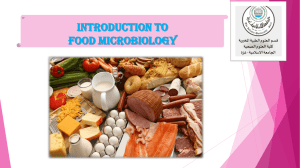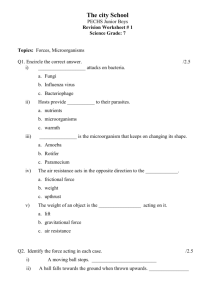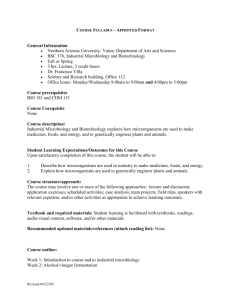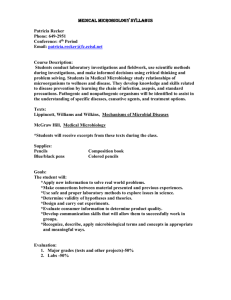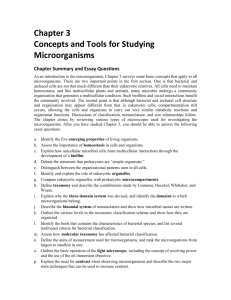PowerPoint
advertisement
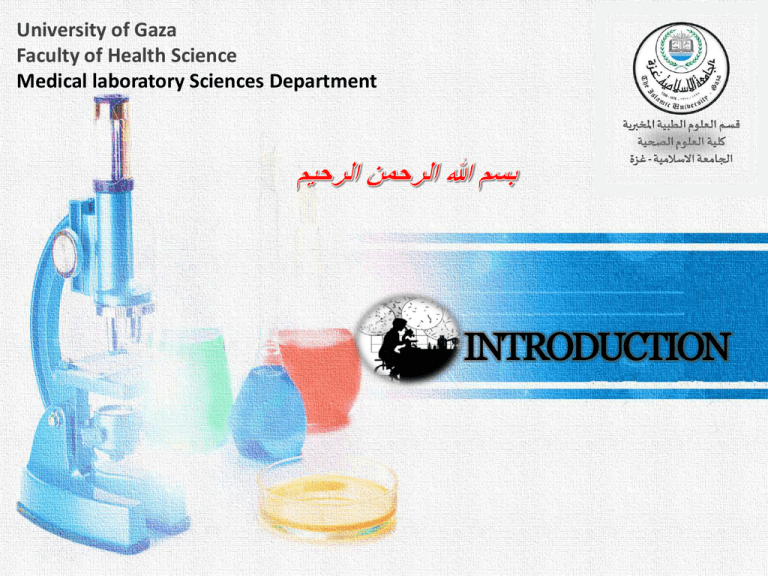
University of Gaza Faculty of Health Science Medical laboratory Sciences Department Introduction • This manual is intended to provide Medical Laboratory Science students with basic techniques for food microbiology laboratory in accordance with standard methods for qualitative and quantitative detection of microorganisms in food and water. • The manual contains: • Procedures for microbial enumeration, isolation and identification of pathogenic food-borne bacteria. • Methods of estimating sanitary indicator microorganisms as well as enumeration of molds and yeasts are also stated. Basics in food microbiology Why analyze food? To meet certain set of standards. To estimate the shelf-life of the product. To determine quality of the food. For public health purposes. What are the Microorganisms that you look for? An indicator organism or group of organisms is one whose numbers in a product reflect the success or failure of GMP "Good Manufacturing Practices". Coliform group of microorganisms and Escherichia coli are commonly used as indicator organisms. Index organism An index organism is one whose presence implies the possible occurrence of a similar but pathogenic organism. E. coli is used an index organism and its presence indicates possible presence of pathogenic enterobacteriacea e.g. Salmonella sp. Food Borne-Pathogens There are two types of food borne-pathogens: 1. Those which cause infection; must grow in food in large numbers and cause infection when consumed together with food. The most common microorganisms in this category includes Salmonella typhimurium, enteropathogenic E. coli, Vibrio parahaemolyticus, Yersinia enterocolytica. 2. Those which cause intoxication must grow in food in large numbers and produce enough toxin and when consumed together with food cause intoxication. The most common microorganisms in this category includes, Clostridium botulinum, Staphylococcus aureus and toxigenic fungi e.g. Aspergillus flavus. Infectious microorganisms Organisms whose presence in small numbers in food or water and when consumed can cause infection. • In this case, the food acts as a vector but not necessarily as a growth medium. • Infectious organisms can be transmitted by various ways including man to man and are said to be contagious. • Organisms in this group includes: Vibrio cholerae O1, Salmonella typhi, Shigella sonnei, Bacillus anthracis, Hepatitis B virus etc. Spoilage organisms Spoilage organisms are the organisms whose growth in the food creates undesirable characteristics in that food. • Any microorganism which is not intentionally added into food or intentionally allowed to grow in food so as to impart certain qualities in that food is considered a contaminant. • Growth of the contaminant in that food will spoil the food making it unfit for human consumption. • Some useful microorganisms e.g. lactic acid bacteria are considered as spoilage organisms when in beer, wine and fruit juices but not in milk. How to analyze? Quantitative analysis • Serial decimal dilution, Aerobic plate count, Pour plate count. • Total viable count. • Most Probable Number (MPN) method. • Yeast and Molds count. Qualitative analysis • • • Presence or absence of a specified microorganism e.g.: Salmonella sp. E. coli V. cholerae O1 Culture Methods Pre-enrichment, broth enrichment, broth selective, enrichment selective agar, Differential agar. Biochemical tests: Sugar fermentation, Amino acid decarboxylation, gelatin liquefaction lecithinase production. Serology: Agglutination precipitin coagulation. Colony morphology: shape, color, texture, size. Cell shape by microscope: Bacillus coccus streptococcus. Gram stain characteristics: Gram positive, gram negative. Motility: Motile; Number of flagella arrangement, non-motile. Laboratory Safety Rules In the food microbiology laboratory infectious materials are processed as many of the microorganisms used in this course may be pathogenic for humans . Equipment, biological agents and chemicals can pose safety hazards to you if you do not follow laboratory protocols. As a result, certain rules are necessary to prevent the spread of infectious agents, the possibility of infecting yourself or other people and to prevent contamination of specimen with environmental microorganisms. Safety in a microbiology laboratory starts with protecting yourself: Cover long hair or keep it tied up and out of way. Always wearing closed shoes. Wearing personal protective equipment (coat, gloves, eye protection; glasses arepreferred). Never applying cosmetics, or placing objects (fingers, pencils) in the mouth or touching the face. Never eating, drinking or chewing gum in the laboratory. Washing hands prior and after lab working with water and soap. Keep the lab bench free of unnecessary materials. Disinfecting lab benches prior to and at the conclusion of each lab session. Good lab practice, including methods for aseptic transfer, returning materials to proper locations, proper care and handling of equipment, and Keeping the bench top clear of extraneous materials. Dispose all contaminated materials in autoclave bags and proper disposal of other different types of waste. The coats should be kept separately from other things in your bag. Reporting all injuries, accidents, spills and broken glassware to the instructor and receiving instructions for cleanup. Always using appropriate pipetting devices and understanding that mouth pipetting is forbidden. Using universal precautions posted in the lab and see inside front cover of this laboratory manual. Read all assigned materials before the lab session. Never lick your fingers, or put your fingers in your mouth. No mouth pipetting. Pick up any sharps, including broken glass with forceps and place in sharps container. Remove gloves and shoes cover before removing area of the spill, put on biohazard bag. Lab requirements Lab coat Matches or lighter Soap Waterproof permanent marker Small or medium size towel Sealable plastic bag Rubber band General Food Microbiology Manual END OF LECTURE
